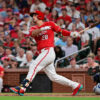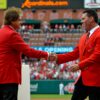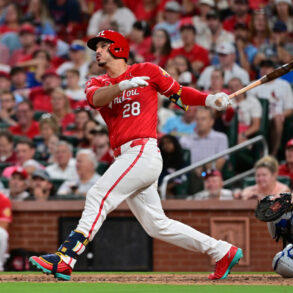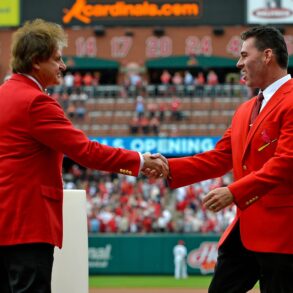For a second straight offseason, Dylan Cease enters spring training as his team’s staff ace … and also as perhaps the most prominent trade candidate in the sport. The Padres, strapped for cash all winter, have made next to no additions to a roster that needs help in left field, at designated hitter and in the final few spots of the rotation. Trading Cease would only exacerbate their rotation need, but he’s the type of arm who could return an immediate fill-in (albeit one with a lower and less established ceiling) in addition to young prospects.
The Padres have entertained offers on the majority of their impending free agents under similar lines of thinking. Cease, Michael King, Luis Arraez and Robert Suarez (opt-out) have all seen their names pop up on the rumor circuit this winter. Cease probably has the most trade value of them all, given his track record, durability, reasonable $13.75MM salary, high-octane arsenal and the potential for an acquiring club to not only add a Game 1 or Game 2 playoff starter to its roster but also to potentially recoup a draft pick in 2026 if/when Cease rejects a qualifying offer in November.
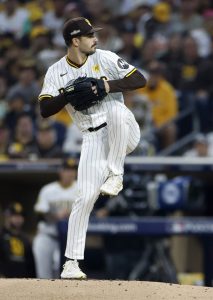
A Cease trade at this juncture would in many ways run parallel to last offseason’s trade of Juan Soto, whom the Padres shipped out for immediate MLB help (King, Kyle Higashioka) and slate of MLB-ready (or close to it) arms: Randy Vasquez, Jhony Brito and top prospect Drew Thorpe. The Padres moved Thorpe before the season even began, using him as the headline prospect to acquire Cease in the first place. Now, they could conceivably trade Cease for a lower-ceiling/less-established rotation arm and some additional pitching depth and/or a young outfielder.
Exact parallels for a Cease swap are hard to come by, though Anthony Franco recently took a look at some general frameworks that the Padres could seek in a piece for Trade Rumors Front Office subscribers. Corbin Burnes, who went from the Brewers to the Orioles in exchange for MLB-ready help in the infield (Joey Ortiz) and on the pitching staff (DL Hall) — plus a competitive balance draft pick — is the clearest comparable in recent memory. Burnes was more consistent but also a bit more expensive ($15.637MM to Cease’s $13.75MM).
It’s feasible to think the Padres could command a big league-ready arm and outfielder to fill two holes on their roster while simultaneously freeing up some cash to backfill some of the innings lost in a Cease trade. Any deal shipping him out will bring back a lesser arm(s), and whatever savings the Padres secure could be used to further address the back of the rotation. San Diego probably isn’t going to give up the picks necessary to sign Nick Pivetta, but the free-agent market still has Andrew Heaney, Kyle Gibson, Cal Quantrill, Spencer Turnbull, Ross Stripling and Alex Wood, among others.
Alternatively, any money saved via trading Cease could be put toward taking on a chunk of a pricey starter’s contract. Marcus Stroman, Jordan Montgomery and Steven Matz are all buy-low candidates but all could probably be had with the current team picking up some of the bill.
Let’s take a look at some of the best fits for Cease based on a variety of factors including team need, payroll availability, luxury tax status and what type of young/inexpensive pitching and outfield help said theoretical trade partners could offer…
Orioles: The Orioles have made several additions to the rotation this winter, but they’re generally lacking ceiling. Charlie Morton and Tomoyuki Sugano would’ve been a higher-end pair to sign back in 2019 than in 2025. They could both still provide some average or even slightly better-than-average innings in bulk, but it’d be a surprise if either looked like a clear playoff-caliber starter at season’s end. Baltimore’s current rotation includes that pair, Zach Eflin, Grayson Rodriguez and Dean Kremer. It’s a solid enough quintet on paper, and they could get late-season help from Kyle Bradish and/or Tyler Wells as that pair mends from a UCL surgeries performed last June.
Baltimore hasn’t replaced Burnes, who signed a six-year deal in Arizona, with an arm of comparable quality. Cease would be just that. Between Kremer, Cade Povich, Trevor Rogers and Chayce McDermott, the O’s have a collection of inexpensive arms who could step into the back half of San Diego’s rotation. The prize for the Padres in a trade with Baltimore would probably be the bat acquired. The Orioles aren’t giving up Coby Mayo or Jackson Holliday for one year of a starter, but Heston Kjerstad once again looks like he’s a man without a clear path to playing time. The O’s could’ve penciled him in to replace Anthony Santander, but they instead signed Tyler O’Neill. Kjerstad turns 26 this month, has nearly a year of MLB service and hasn’t been given a full-time look. The O’s have touted outfielders like Enrique Bradfield Jr. and Dylan Beavers on the rise behind him, plus Colton Cowser already in the majors.
Red Sox: Boston hasn’t made the big free-agent splash that many expected, but it’s hard to say that any team that acquired Garrett Crochet hasn’t invested in bolstering the rotation. Crochet joins Tanner Houck, Brayan Bello, Kutter Crawford, free agent signee Walker Buehler and (eventually) a returning Lucas Giolito in a deep and talented Red Sox rotation mix. You could argue the Sox don’t need to further augment the group, but Buehler is a rebound candidate and Giolito could be on some kind of set workload. Even if that’s not the case, a September (and hopefully for Craig Breslow & Co., October) rotation scene including Crochet, Cease, Giolito, Houck and Buehler could be overpowering.
Crawford wilted considerably down the stretch, but he has four years of control remaining and is earning just $2.75MM this season. Depth arms like Quinn Priester, Richard Fitts and Cooper Criswell could all hold appeal to the Padres as well. None of that group has reached arbitration. Criswell is controlled for five more years. Priester and Fitts can be controlled for six. The Sox aren’t giving up Jarren Duran or Ceddanne Rafaela for a year of Cease, but would they consider selling high on Wilyer Abreu? They could turn to an outfield stopgap like Randal Grichuk or Mark Canha to give them a right-handed bat while leaving the door open for uber prospect Roman Anthony to seize a regular job sooner than later.
Twins: The Twins’ interest in Cease is a head-scratcher at first glance, if only because Minnesota is in a similar payroll crunch to the Padres. However, as the offseason has gone on, it’s been reported that Minnesota might not actually need to cut payroll and might even have a couple million to spend. The Twins could shed some money in other trades, perhaps shipping out Chris Paddack ($7.5MM), some of Christian Vazquez’s contract (one year, $10MM remaining) and/or utilityman Willi Castro ($6.4MM). A trade with the Padres could also send a bit of money to San Diego, depending on which pitcher(s) and/or outfielders are included.
The Twins have Pablo Lopez, Joe Ryan, Bailey Ober, Simeon Woods Richardson and Paddack in the rotation at present, with top prospects David Festa and Zebby Matthews already having made their major league debuts. Other arms like Andrew Morris and Travis Adams aren’t terribly far from getting a look. The Athletic’s Dan Hayes recently suggested that the Padres would probably want Ryan or Ober to headline a deal. Ryan seems like a bridge too far for the Twins. Ober is earning $3.35MM this season and has three years of club control remaining. Any of Woods Richardson, Festa and/or Matthews is pre-arbitration. The Twins have young outfielders like Trevor Larnach and Matt Wallner to pitch. Larnach is making $2.1MM. Trading one of Larnach or Wallner could open a clearer path for top prospects Emmanuel Rodriguez or Luke Keaschall to step into the big leagues. Keaschall has played more infield, but the Twins’ infield is already quite crowded, so his eventual home could be in the outfield or in a multi-position role.
Braves: With Spencer Strider on the mend from UCL surgery and expected back sometime in May, the Braves don’t necessarily have a glaring rotation need. Chris Sale, Reynaldo Lopez, Strider and Spencer Schwellenbach will create a formidable top four — health permitting. Righties Ian Anderson, Grant Holmes, Bryce Elder, AJ Smith-Shawver and Hurston Waldrep are in the mix for starts while Strider is out and give Atlanta ample depth for the fifth spot in the rotation should each of the top four be healthy early in the summer. Drue Hackenberg, a 2023 second-rounder, climbed three minor league levels and posted sharp results across the board in 2024, providing even more depth.
That glut of arms for what ostensibly appears to be one final rotation spot gives Atlanta plenty of options on the trade market. If the Padres want to acquire multiple lower-end but MLB-ready arms in exchange for Cease, the Braves are a potentially prime trade partner. President of baseball operations Alex Anthopoulos has implied that any rotation addition would need to be a clear upgrade over Anderson and Holmes, who are out of minor league options and thus virtual locks to make the roster. Cease checks that box emphatically. And with Jurickson Profar now in the outfield, Atlanta could at least consider the possibility of including Jarred Kelenic in a deal as well. Kelenic’s value is way down after a middling 2024 season, but he has four seasons of club control remaining and — once Ronald Acuña Jr. is healthy — minimal path to everyday at-bats on a roster with Profar, Acuña and Michael Harris II.
Cubs: As with the Braves, the Cubs have a deep collection of arms competing for what looks to be one rotation spot. Justin Steele, Shota Imanaga, Jameson Taillon and Matthew Boyd are all rotation locks. Candidates for the fifth spot include Javier Assad, Jordan Wicks and Ben Brown — with top prospect Cade Horton on the rise as well. Assad is probably the favorite thanks to a 3.40 ERA through his first 294 big league frames, but below-average command and a subpar strikeout rate lead to less-appealing marks from alternative metrics like FIP (4.49) and SIERA (4.66). The Cubs also signed veteran Colin Rea on a one-year deal, giving them a seasoned No. 5 option or swingman in the bullpen.
On top of the plethora of young arms, the Cubs have two top-100 outfield prospects in Owen Caissie (an original Padres draftee who went to the Cubs in the Yu Darvish trade) and Kevin Alcantara. Both are essentially MLB-ready. Alcantara has already debuted. Chicago has Ian Happ, Pete Crow-Armstrong and Kyle Tucker in the outfield with Seiya Suzuki at designated hitter. There’s no path to 2025 playing time for Caissie or Alcantara if the current outfield is healthy. Plus, Happ and Suzuki are signed through 2026 while Crow-Armstrong is controlled all the way through 2030. Dealing from their stock of outfield talent to further cement themselves as the NL Central favorite and add a clear playoff starter makes good sense. The Cubs already made a big one-year bet on Tucker. That ought to embolden them to further push all-in on 2025. At the very least, they could expect 2026 draft compensation for Tucker and Cease, lessening the sting of some of the prospects they surrender.
Mets: President of baseball operations David Stearns doesn’t seem to want to commit long-term to starting pitchers, making Cease a natural target. He’d immediately ascend to the top of the rotation in Queens, giving the Mets the clear Game 1 type of starter they presently lack. Cease, Kodai Senga and Sean Manaea would make a nice top three, with Frankie Montas, Clay Holmes, David Peterson and Paul Blackburn as options to round out the staff … unless, of course, Peterson is one of the names headed back to the Padres in a theoretical trade package. Like Cease and Michael King last year, he has two seasons of club control remaining. He’d give the Friars an experienced arm to take up some of Cease’s innings, and the Mets have plenty of additional names to offer on top of that.
Tylor Megill doesn’t look to have a clear spot on the roster, barring injuries. He looks like more of a depth piece but could add some innings to the San Diego rotation. Top pitching prospect Brandon Sproat is the type of near-MLB arm who could serve as a headliner. The Mets also have appealing young hitters like Brett Baty, Ronny Mauricio and Luisangel Acuña. All three are infielders, but they’ve all at least tinkered in the outfield as well. All three have the athleticism to handle left field. Mauricio is recovering from an ACL tear and might not be ready for Opening Day, while Acuña struggled in the minors last year and could need more seasoning. Regardless, they could be early-season options, while someone like Baty might be an option to step right into left field if the Padres feel a spring training of work there could ready him for a full-time look in the majors.
—
There are, of course, other clubs that have rotation needs and would surely inquire. The Angels seem like an obvious fit but don’t necessarily have the collection of young arms and/or outfielders that the above teams possess. Jo Adell already has three years of MLB service and has yet to establish himself. Taylor Ward is only controlled through 2026 and is making nearly $8MM. The Angels need controllable young arms just as badly as the Padres.
The Blue Jays make some sense, as a team aggressively pursuing 2025 upgrades, but they’ve made those upgrades without sacrificing much in the way of prospects — perhaps in a nod to a potential Plan B if this year’s run at contention doesn’t pan out.
The Rangers, Brewers and Guardians could all make varying degrees of sense, but all three are running up against payroll issues at this point. Texas could try to send Jon Gray and/or Leody Taveras back to San Diego, but they’d need to include significant prospects to offset that pair’s lack of long-term value. The Brewers haven’t signed a free agent to a fully guaranteed deal and seemingly have no money to spend. The Guards haven’t rented a veteran starter like this at any point in recent memory and may be tapped out after re-signing Shane Bieber, Austin Hedges and Carlos Santana and signing Paul Sewald. Perhaps the Tigers could try to package some younger arms (e.g. Casey Mize, Matt Manning, Keider Montero, Ty Madden) and a young hitter like Justyn-Henry Malloy, but their recent addition of Jack Flaherty seems like their final move in the rotation.
Broadly, it’s pretty easy to make a case for Cease on quite a few teams. He’s a Cy Young-caliber arm at his best and is being paid less than the collection of aging veteran arms who signed one-year deals worth $15-16MM this winter (Justin Verlander, Max Scherzer, Charlie Morton, Alex Cobb). The best fits, at least from our vantage point, appear to reside in Baltimore, Boston, Atlanta, Minneapolis, Chicago (Cubs) and New York (Mets), however.
This post was originally published on this site be sure to check out more of their content.


